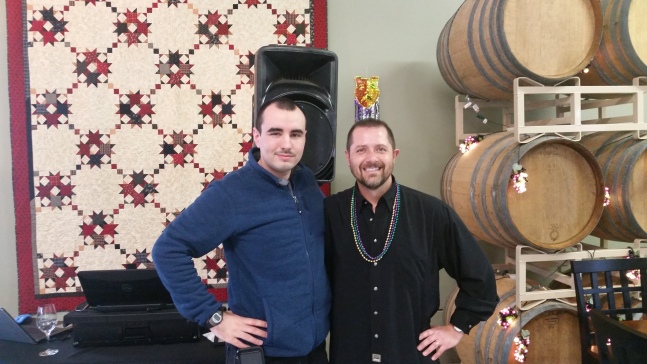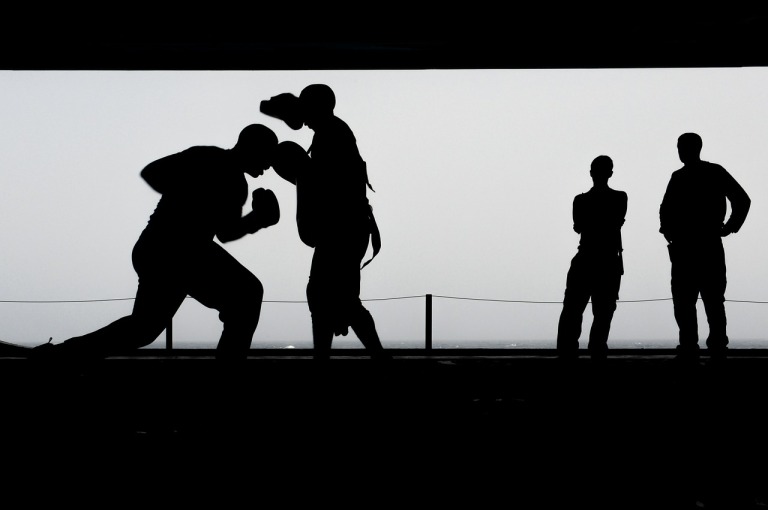 It was my pleasure to interview Barry MacGuire for Exercise 4, in my Introduction to Media Arts 101 class. I caught up with Barry while he was working at a Mardi Gras event, acting as the Master of Ceremonies and DJ. I had prepared a list of questions, many of which he answered in the course of our conversation without me asking directly. I have listed the question asked directly, and in parentheses are the related questions that were also answered.
It was my pleasure to interview Barry MacGuire for Exercise 4, in my Introduction to Media Arts 101 class. I caught up with Barry while he was working at a Mardi Gras event, acting as the Master of Ceremonies and DJ. I had prepared a list of questions, many of which he answered in the course of our conversation without me asking directly. I have listed the question asked directly, and in parentheses are the related questions that were also answered.
What got you started in audio? (What got you interested in audio? What got you started in being a DJ? What got you interested in being a DJ? How long have you been doing audio work?)
Barry is originally from Vancouver Canada. In high school, he wanted to be a dentist. But after taking the classes that were related to that field, he decided that dentistry was not for him. In considering his options, he thought about what else he might like. “I like radio, I like sports. I originally got in to radio to be a sports caster.” He attended Columbia School of Broadcasting, in Los Angeles for a year. The first job available after broadcast school was in music radio, up in Bellingham Washington, where he commuted 30 miles across the border for 6 months. “I have been doing music ever since.”
Barry has worked in San Jose, California, Redding California, Shyanne, Wyoming and for the last 21 years or so, in Eugene. The first 13 years he lived in Eugene, Barry was at KDUK, 104.7. For the last 8 years, Barry has been doing the afternoon show on KOOL 99.1.
Barry MacGuire also owns his own company, BMAC Productions, offering services such as master of ceremonies and disc jockey at events and weddings. “It includes two other radio DJ’s and myself,” Barry explained. He went on to say that they are very good at working with the microphone and working with the public. In this way, his company is a bit different from other disc jockeys in that they are used to “MC’ing” large events. “It’s easy to play the music and press the button, but it is very tough to get on the mic as Master of Ceremonies and keep the audience interested. It sets us aside from other companies.”
What types of jobs have you done with audio? (What do you do now at the radio station?)
“Mostly working in radio, that’s my main job.” Barry MacGuire is the Program Director at KOOL 99.1. Being Program Director involves daily scheduling of the music, dealing with staff issues, commercial promotions such as give aways, or whatever they are doing at the time. He also does quite a few commercials at the radio station. It is an 8 am to 7 pm job, as opposed to the typical disc jockey who begins at 2 in the afternoon and is done by 7 in the evening. It’s a pretty long day.
Then there is the work Barry does with BMAC Productions. “I got involved with that, so that my wife could be a stay at home mom,” with their two young children. This choice was very important to his family. BMAC is a good second source of income for them. “I really like it, it’s a lot of fun.” Barry says he really enjoy working at Sweet Cheeks, Bennett’s, King Estates, Paradise Springs, … lots of the vineyards, “…they are really fun.” “I enjoy weddings the most. It’s a positive event, everybody is there to have a great time.”
What is your training? Formal and informal?
At Columbia, Barry says that they did not learn a lot about the technical side of things, “the focus was on the content and delivery of what we were doing.” He learned commercial writing for 30 second spots and 60 second spots, and how to deliver that commercial. It was more about voice work.
What advice do you have for those of us starting out in the field?
“Best way to get in to a field, this or any other really, is to volunteer some time, … intern. That way you are getting hands on experience and seeing if you like the industry.” When Barry is looking to hire a prospective person, he considers three things.
- Being outgoing, not afraid to get on the microphone and entertain the crowd. It doesn’t have to be too crazy, just as long as you are a good communicator, that is what counts.
- Being responsible, showing up on time, looking presentable. A lot of times those two things (items #1 And #2) don’t always go together.
- “Having some music knowledge, know the music that you are playing. You need to know your audience, like if you have an older crowd, or a younger crowd, just kind of know how to cater to those people and play the songs that they want to hear. Keep them on the dance floor. Same in radio, cater to the audience.”
I asked Barry about his technical set up, what does one need to know about the hardware?
Barry said it’s pretty basic, plug in the speakers and turn things on. “Computers do it all, play list and all.” Barry uses Virtual DJ. He controls the laptop with his control board (like an old school control board). He uses a SURE microphone. It’s a cardioid type of microphone.
At the radio station, they have two engineers, who work with a number of radio stations. Once they come in and set the levels, “we don’t do much to change them.” The engineers also fix things that break. They generally visit monthly.
In working with the commercials and editing sound, the station use Cool Edit Pro. However, Barry said that what we are using at Lane Community College, Pro Tools, is the industry standard. Most people in industry use Pro Tools. The station is switching over to Adobe Audition (who bought Cool Edit Pro), but Pro Tools is what most people use. Barry records and edits all the commercials and is responsible for the sound effects as well.
Barry invited me to stop by the radio station sometime to look around. We discussed the possibility of my doing some volunteer work with him editing commercials over the summer. I really enjoyed my time with him. He is a very nice person and easy to talk with. I look forward to seeing him again sometime soon.




 It was my pleasure to interview Barry MacGuire for Exercise 4, in my Introduction to Media Arts 101 class. I caught up with Barry while he was working at a Mardi Gras event, acting as the Master of Ceremonies and DJ. I had prepared a list of questions, many of which he answered in the course of our conversation without me asking directly. I have listed the question asked directly, and in parentheses are the related questions that were also answered.
It was my pleasure to interview Barry MacGuire for Exercise 4, in my Introduction to Media Arts 101 class. I caught up with Barry while he was working at a Mardi Gras event, acting as the Master of Ceremonies and DJ. I had prepared a list of questions, many of which he answered in the course of our conversation without me asking directly. I have listed the question asked directly, and in parentheses are the related questions that were also answered.